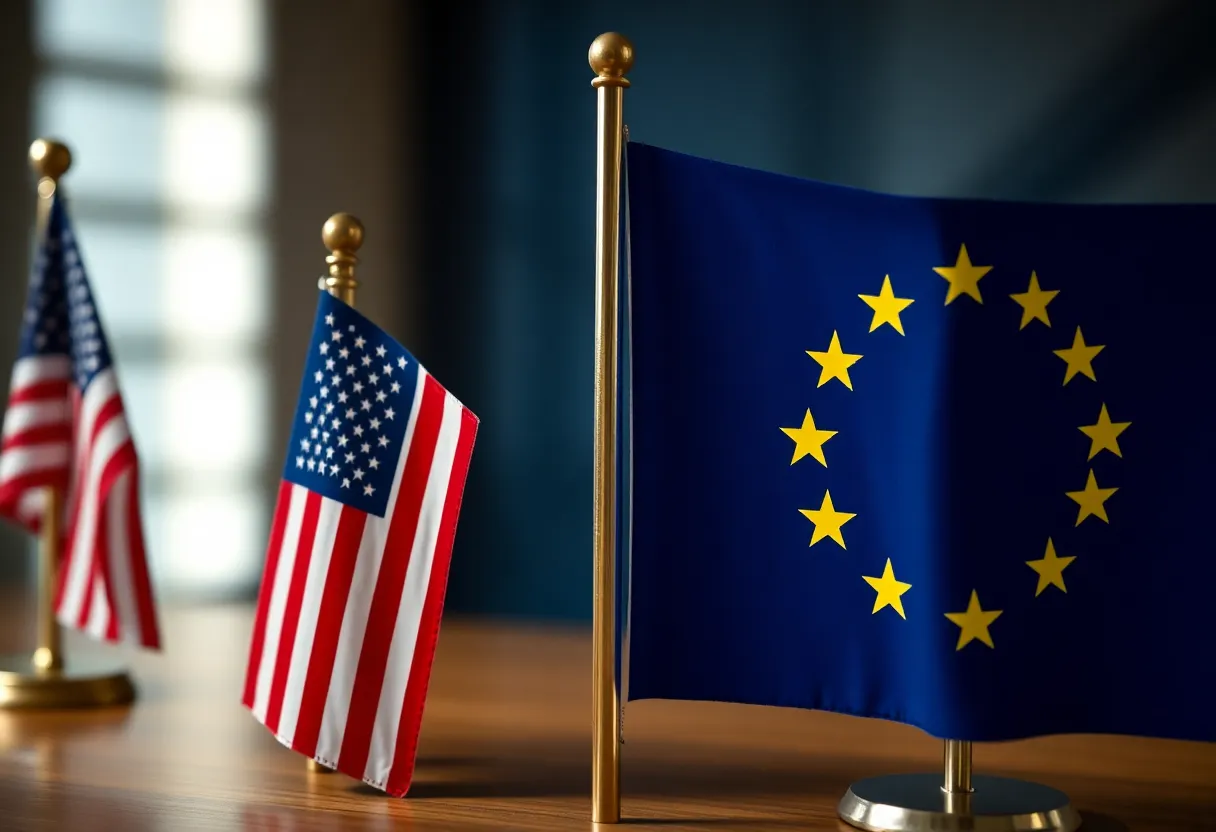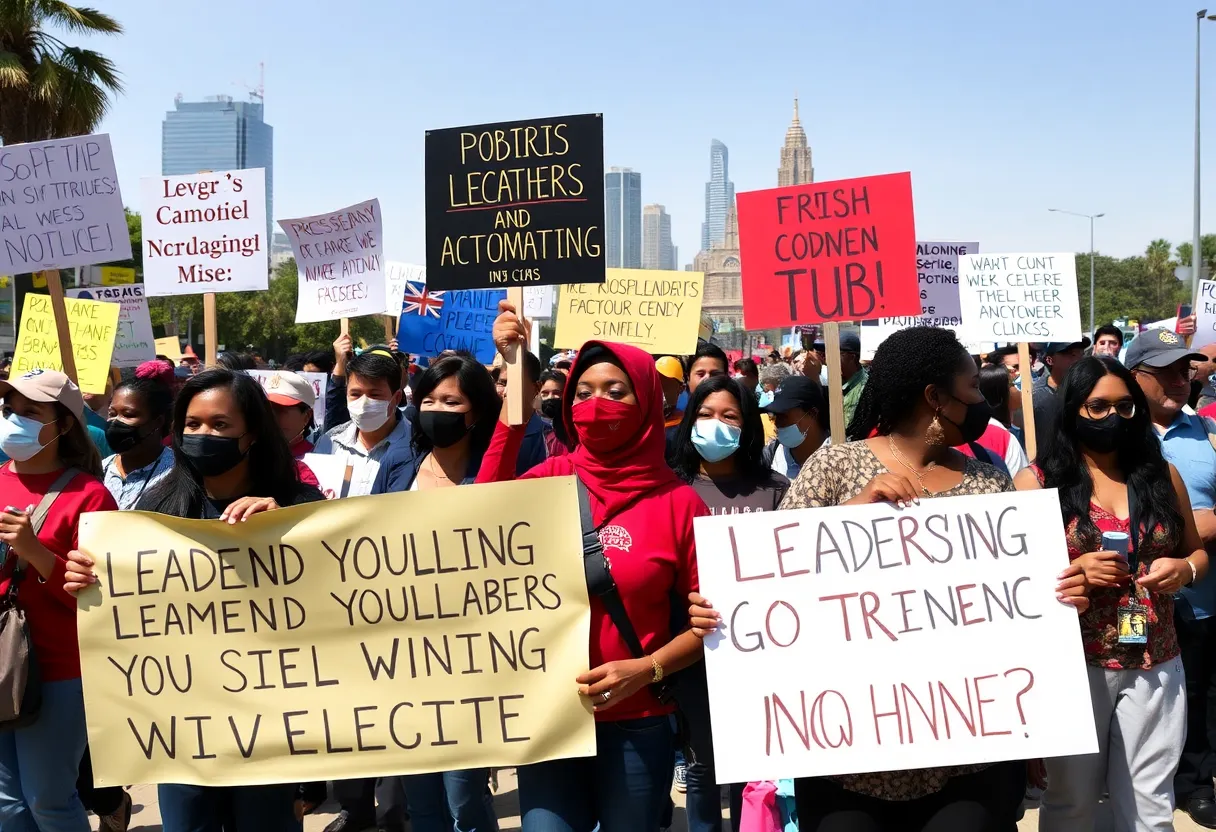News Summary
U.S. President Donald Trump is intensifying trade negotiations with the European Union, setting a hard deadline for a deal by August 1. With potential tariffs of up to 30% on certain EU imports looming, the EU is considering retaliatory measures against $21 billion worth of U.S. products. Amidst these threats, analysts remain cautiously optimistic following a recent trade agreement between the U.S. and Japan. The automotive industry, a critical sector in these discussions, faces significant impact as both sides navigate heightened tensions and seek a resolution to their strained trade relations.
Trump Targets EU with Looming Tariff Threat Amidst Weak Trade Negotiations
As the world keeps its eyes on global trade dynamics, U.S. President Donald Trump is stirring the pot with some serious trade negotiations with the European Union (EU). Following a recently announced deal with Japan, Trump has turned his focus across the Atlantic. He’s not wasting any time and has confirmed that EU negotiators are set to meet in the coming days.
Urgency in Negotiations
The clock is ticking for both U.S. and EU negotiators, who are under pressure to finalize a deal by August 1. Trump has made it clear that the timeline for tariffs remains unchanged, adding to the urgency. In fact, there’s talk of a whopping 30% tariff on certain U.S.-bound imports from the EU that could come into play as soon as next month.
EU’s Retaliatory Measures
In response to these potential tariffs, the EU is not sitting idly by. They are already considering their own retaliatory measures against about $21 billion worth of U.S. imports that are currently being held up until August 6. With such high stakes, one can sense the tension simmering just below the surface.
Optimism Amidst Uncertainty
Despite the daunting task ahead, some experts remain hopeful. The recent U.S.-Japan trade agreement has sparked optimism that a similar deal can be achieved with the EU. In this agreement, the baseline tariff rate was lowered to 15%, down from the previous 25% for auto tariffs. This has led EU analysts to believe that a fair baseline tariff might be negotiable in exchange for key exemptions for certain sectors.
Automotive Industry at Stake
The automotive industry plays a significant role in these negotiations, as it ranks among the top three exports from the EU to the U.S. The outcome of these trade talks could be crucial for this sector, especially with the pan-European Stoxx 600 index showing a positive response—rising by 1% with auto stocks seeing an impressive 3.5% increase.
Shifting Trade Dynamics with China
Adding another layer of complexity is the EU’s ongoing relationship with China. European leaders are currently in talks with their Japanese counterparts, all while preparing for an upcoming EU-China summit. Tensions have heightened due to Trump’s protectionist policies, raising fears that the U.S. might pressure the EU to adopt a tougher stance on China.
Anti-Coercion Instrument on the Table
In light of potential tariffs from the U.S., the EU is considering deploying its “Anti-Coercion Instrument”. This regulatory measure allows the EU to retaliate against what it perceives as economic pressures from other countries. Should a deal not materialize, the EU could impose restrictions on U.S. suppliers, which might limit their access to the EU market. This could have significant implications, especially for foreign direct investments and import/export restrictions.
Current Trade Relations Strained
Currently, the trade relations between the U.S. and EU are far from smooth. The U.S. has accused the EU of engaging in unfair trading practices, primarily focused on the persistent trade surplus that the EU maintains. In 2024, total trade between the two was approximately €1.68 trillion. While the EU enjoys a surplus in goods, it faces a deficit in services.
Counter-Tariff Discussions
As the August deadline looms closer, officials on the EU side have been discussing potential counter-tariffs that could target U.S. imports. Sectors like pharmaceuticals and automobiles could be significantly impacted, with major players such as Germany being hit hard in the automotive sector. The EU has pointed out that Trump’s tariffs could essentially “prohibit” trade between these economies, which are deeply intertwined.
Looking for an Amicable Solution
Even with these rising tensions, it seems that the EU would prefer to find an amicable solution rather than escalate matters further. After all, maintaining a strong partnership with the U.S. is vital as they navigate these challenging trade dynamics. With so much at stake for both parties, the coming days and weeks will certainly be closely watched for any developments in these crucial negotiations.
Deeper Dive: News & Info About This Topic
- CNBC: Europe Has a Trade Bazooka Against Trump’s Trade Tariffs
- Google Search: EU trade tariffs
- CNN: China-EU Summit Analysis
- Wikipedia: Trade and Development
- Financial Times: [Article Title]
- Encyclopedia Britannica: International Trade
- Bloomberg: EU Is Racing to Secure US Trade Deal
- Google News: US EU trade negotiations
- Washington Post: Trump’s Tariffs Could Upend US Trade with EU
- Google Scholar: EU US trade relations

Author: STAFF HERE LOS ANGELES WRITER
The LOS ANGELES STAFF WRITER represents the experienced team at HERELosAngeles.com, your go-to source for actionable local news and information in Los Angeles, Los Angeles County, and beyond, specializing in "news you can use" with coverage of product reviews for personal and business needs, local business directories, politics, real estate trends, neighborhood insights, and state news affecting the area—with deep expertise from years of dedicated reporting and strong community input, including local press releases and business updates, while delivering top reporting on high-value events like the Academy Awards, LA Auto Show, and Los Angeles Marathon, extending coverage to key organizations such as the Los Angeles Area Chamber of Commerce and the Los Angeles Tourism & Convention Board, plus leading businesses in entertainment and technology like Warner Bros. and SpaceX, and as part of the broader HERE network including HEREAnaheim.com , HERECostaMesa.com , HEREHuntingtonBeach.com , and HERESantaAna.com , providing comprehensive, credible insights into Southern California's dynamic landscape. HERE Anaheim HERE Beverly Hills HERE Coronado HERE Costa Mesa HERE Hollywood HERE Huntington Beach HERE Long Beach HERE Los Angeles HERE Mission Viejo HERE San Diego HERE Santa Ana





